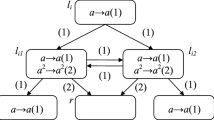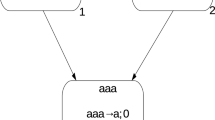Abstract
P systems were introduced more than two decades ago by Gheorghe Pǎun. They are known as nondeterministic maximally parallel computing models. Most of their variants are proved to be capable of solving NP problems in polynomial time. This work focuses on using neural-like P systems to simulate uniform sequential computing models. In particular, we consider a so-called Spiking Neural P module (SN P module) computing finite-state functions. We define and characterize a so-called (SN) P automatic sequence by SN P modules.












Similar content being viewed by others
References
Allouche, J.-P., & Shallit, J. (2003). Automatic sequences: Theory, applications, generalizations. Cambridge: Cambridge Iniversity press.
Cabarle, F.G., Buno, K.C., & Adorna H.N. (2012). Spiking neural P systems generating the Thue-Morse sequnce. In: Pan, L., et al. Pre-proceedings of Asian Conference on Membrane Computing, pp 161-169
Cabarle, F. G. C., Adorna, H. N., & Perez-Jimenez, M. J. (2016). Notes on spiking neural P systems and finite automata. Natural Computing, 15(4), 533–539.
Carandang, J. P., Villaflores, J. M., Cabarle, F. G., Adorna, H. N., & Martinez-del-Amor, M. A. (2017). CuSNP: Spiking neural P systems simulators in CUDA. Romanian Journal of Information Science and Technology, 20(1), 57–70.
Chen, H., Ionescu, M., Ishdorj, T.-O., Pǎun, A., Pǎun, Gh, & Perez-Jimenez, M. J. (2008). Spiking neural P systems with extended rules: Universality and languages. Natural Computing, 7, 147–166.
de la Cruz, R. T. A., Cabarle, F. G., & Adorna, H. N. (2019). Generating context-free languages using spiking neural P systems with structural plasticity. Journal of Membrane Computing, 1, 161–177.
Martínez-del-Amor, M.Á., Orellana-Martín, D., Cabarle, F.G.C., Pérez-Jiménez, M.J., & Adorna, H.N. (2017). Sparse-matrix representation of spiking neural P systems for GPU. Fifteenth Brainstorming Week on Membrane Computing (BWMC2017) Fénix Editora. Sevilla, Spain pp. 161–170.
Ibarra, O. H., Perez-Jimenez, M. J., & Yokomori, T. (2010). On spiking neural P systems. Natural Computing, 9, 475–491.
Ionescu, M., Paun, G., & Yokomori, T. (2006). Spiking neural P systems. Fundamenta Informaticae, 71(2–3), 279–308.
Jimenez, Z. B., Cabarle, F. G. C., de la Cruz, R. T. A., et al. (2019). Matrix representation and simulation algorithm of spiking neural P systems with structural plasticity. Journal of Membrane Computing, 1, 145–160.
Manuel, G.A. (2007) P system and automata. Department of Mathematics Undergraduate Thesis, UPDiliman.
Ochirbat, O., Ishdorj, T., & Cichon, G. (2020). An error-tolerant serial binary full-adder via a spiking neural P system using HP/LP basic neurons. Journal of Membrane Computing, 2, 42–48.
Pan, L., Wu, T., & Zhang, Z. (2006). A bibliography of spiking neural P systems. BULLETIN of the International Membrane Computing Society (I M C S), 1(1), 63–78.
Pǎun, G. (2000). Computing with membranes. Journal of Computer System Sciences, 61(1), 108–143.
Pǎun, G. (2002). Membrane computing—An introduction. Berlin: Springer.
Pǎun, G., Rozenberg, G., & Salomaa, A. (Eds.). (2010). Handbook of membrane computing. Oxford: Oxford University Press.
Salomaa, A. (1973). Formal languages. Cambridge: Academic Press, Inc.
Sipser, M. (2006). Introduction to the theory of computation (2nd ed.). Boston: Thompson Course tech.
Song, B., Li, K., Orellana-Martin, D., Valenia-Cabrera, L., & Perez-Jimenez, M. J. (2020). Cell-like P systems with evolutional symport/antiport rules and membrane creation. Information and Computation,. https://doi.org/10.1016/j.ic.2020.104542.
Song, B., Zeng, X., Jiang, M., & Perez-Jimenez, M. J. (2020). Monodirectoonal tissue P systems with promotere. IEEE Transactions on Cybernetics,. https://doi.org/10.1109/TCYB.2020.3003060.
Acknowledgements
The author would like to thank the support from DOST-ERDT research grants; Semirara Mining Corp. Professorial Chair for Computer Science of College of Engineering, UPDiliman; RLC grant from UPD-OVCRD.
Author information
Authors and Affiliations
Corresponding author
Additional information
Publisher's Note
Springer Nature remains neutral with regard to jurisdictional claims in published maps and institutional affiliations.
Rights and permissions
About this article
Cite this article
Adorna, H.N. Computing with SN P systems with I/O mode. J Membr Comput 2, 230–245 (2020). https://doi.org/10.1007/s41965-020-00059-7
Received:
Accepted:
Published:
Issue Date:
DOI: https://doi.org/10.1007/s41965-020-00059-7




